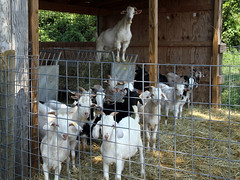A study was conducted at the University of Maryland's Western Maryland Research & Education Center to compare the performance and carcass characteristics of pen-fed vs. pasture-fed meat goats. Thirty (mostly Kiko) bucklings were randomly assigned to two treatment groups: 1) pen-fed; and 2) pasture-fed.
The pen-fed goats (n=15) were kept in a dry lot and fed a hay-grain diet. The pasture-fed goats (n=15) were grazed alongside the goats in the 2012 Western Maryland Pasture-Based Meat Goat Performance Test.
After a 12-day adjustment period and consuming their respective diets for 84 days, the goats were harvested to collect carcass data. The carcasses were deboned and separated into fat, bone, and lean. A sample of the longissimus dorsi muscle is being analyzed for fatty acid content. |
| Pen-fed |
 |
| Pasture-fed |
The pen-fed goats (n=15) were kept in a dry lot and fed a hay-grain diet. The pasture-fed goats (n=15) were grazed alongside the goats in the 2012 Western Maryland Pasture-Based Meat Goat Performance Test.
In contrast with a similar study conducted in 2011, the pasture-fed goats had a higher rate-of-gain than the pen-fed goats (0.183 vs. 0.149 lb/d). However, the pen-fed goats had lower worm burdens, as evidenced by lower average fecal egg counts (565 vs. 1163 epg) and lower average FAMACHA scores (1.6 vs. 1.8). There were no differences in body condition, coat condition, and dag scores.
Though there were differences among individual goats, carcass data did not differ between the groups, as goats from both groups yielded an average of 18.75 percent fat-free, boneless meat. A Myotonic buck in each group had the highest-yielding carcass.
The 2012 study was funded by the Maryland Grain Producers Utilization Board.
Read full article (HTML)
Download carcass data (PDF)

No comments:
Post a Comment